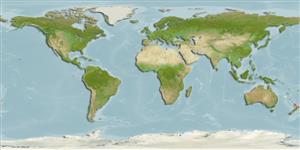>
Gobiiformes (Gobies) >
Gobiidae (Gobies) > Gobiinae
Etymology: Eviota: No etymology given, suggested by Christopher Scharpt: from Latin 'eu' for 'true' and 'iota' for anything very small, in combination 'truly very small' referring to it as being the smallest vertebrate at the time it has benn described by Jenkins (thus, making the suggestion by Scharpt plausible.; kermadecensis: Named for its type and only known locality, the Kermadec Islands of New Zealand..
Environment: milieu / climate zone / depth range / distribution range
Ecología
marino bentopelágico; rango de profundidad 0 - 29 m (Ref. 93112). Subtropical
Southwest Pacific: New Zealand (Kermadec Islands).
Tamaño / Peso / Age
Maturity: Lm ? range ? - ? cm
Max length : 2.1 cm SL macho / no sexado; (Ref. 93112); 1.7 cm SL (female)
Short description
Morfología | Morfometría
Espinas dorsales (total): 7; Radios blandos dorsales (total): 9-10; Espinas anales 1; Radios blandos anales: 8 - 9; Vértebra: 26. This species is distinguished from its congeners by the following set of characters: D usually VI + I,10; A usually I,8; most pectoral-fin rays branched; cephalic sensory-pore system pattern 1 (terminal lateral canal pore present); males with first dorsal spine filamentous, base of pectoral fin with 2 spots (darker than body color or much lighter than body color), lower spot usually smaller than upper and sometimes obscure; 4 segmented pelvic-fin rays plus a rudimentary fifth ray present, pelvic rays partly separated, connected about one-third to one half between segmented rays 2-4 and almost completely connected to tip between spine and first ray; rudimentary fifth pelvic ray bound in membrane to fourth ray; subcutaneous bars on lower trunk behind anus usually lacking in preserved adults; nasal tubes short, tips of tubes with thin black ring, dorsal, anal and caudal fins usually grey to black; dorsal fin with some light spots; vertebrae usually 26 (Ref. 93112). Dorsal to anal fin-ray formula 10/8 (Ref. 116739).
Found in rocky reefs (Ref. 93112).
Life cycle and mating behavior
Madurez | Reproducción | Puesta | Huevos | Fecundidad | Larva
Hoese, D.F. and A.L. Stewart, 2012. A new species of the gobiid genus Eviota (Teleostei: Gobioidei) from the Kermadec Islands, New Zealand. Zootaxa 3418:61-67. (Ref. 93112)
IUCN Red List Status (Ref. 130435)
Threat to humans
Harmless
Human uses
Más información
Nombres comunesSinónimosMetabolismoDespredadoresEcotoxicologíaReproducciónMadurezPuestaAgregación para la puestaFecundidadHuevosEgg development
Age/SizeCrecimientoLength-weightLength-lengthLength-frequenciesMorfometríaMorfologíaLarvaDinámica larvariaReclutamientoAbundanciaBRUVS
ReferenciasAcuiculturaPerfil de acuiculturaRazasGenéticaElectrophoresesheritabilidadEnfermedadesProcesamientoNutrientsMass conversion
ColaboradoresImágenesStamps, Coins Misc.SonidosCiguateraVelocidadTipo de nataciónSuperficie branquialOtolitosCerebrosVisión
Herramientas
Special reports
Download XML
Fuentes de Internet
Estimates based on models
Preferred temperature (Ref.
123201): 16.2 - 21, mean 20.3 °C (based on 7 cells).
Phylogenetic diversity index (Ref.
82804): PD
50 = 0.5000 [Uniqueness, from 0.5 = low to 2.0 = high].
Bayesian length-weight: a=0.00708 (0.00333 - 0.01504), b=3.09 (2.92 - 3.26), in cm total length, based on LWR estimates for this (Sub)family-body shape (Ref.
93245).
Nivel trófico (Ref.
69278): 3.1 ±0.3 se; based on size and trophs of closest relatives
Resiliencia (Ref.
120179): Alto, población duplicada en un tiempo mínimo inferior a 15 meses (Preliminary K or Fecundity.).
Fishing Vulnerability (Ref.
59153): Low vulnerability (10 of 100).
